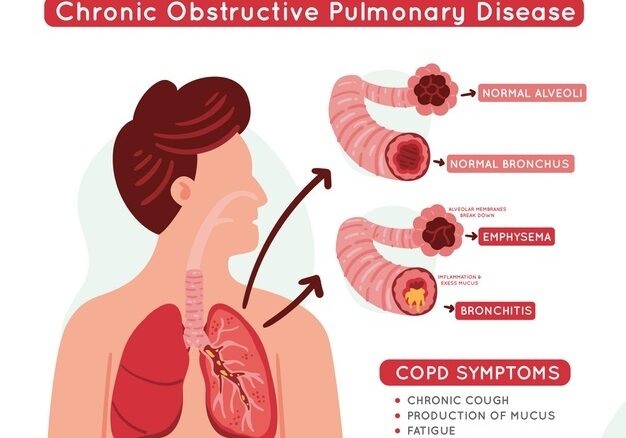CHRONIC OBSTRUCTIVE PULMONARY DISEASE
OUTLINE
- Introduction
- Causes/Risk factors
- Clinical features
- Diagnosis
- Complications
- Management
- Prevention
INTRODUCTION
This is a group of progressive lung diseases that causes obstruction to airflow.
Although it is progressive in nature, it can be treated.
Smoking is a major cause and the longer and more tobacco taken, the greater the risk of developing COPD.
The two most common conditions associated with COPD are Emphysema and Chronic Bronchitis.
Chronic bronchitis is the inflammation and subsequent narrowing of the lining of the bronchial tubes while emphysema is the progressive destruction of the air sacs in the lungs.
CAUSES/RISK FACTORS
- Long term tobacco smoking (especially in developed countries) including second hand smokes.
- Prolonged exposure to fumes from burning fuel for cooking.
- Prolonged history of heating in a poorly ventilated area.
- Asthma; the risk factor increasing in association with smoking.
- Prolonged occupational exposure to dusts and chemicals.
- Alpha-1-antitrypsin deficiency (RARE)
Alpha-1-antitrypsin is made in the liver and secreted into the blood stream to help protect the lungs. Thus, deficiency can cause both liver and lung diseases.
CLINICAL FEATURES
Typically develop following prolonged exposure to irritants. Symptoms develop gradually and consequently progress to increasing difficulty in breathing.
- Difficulty in breathing.
- Progressive cough
- Wheezing and chest tightness
- Weight loss, fatigue and leg edema at later stages.
COMPLICATIONS
These include;
- Respiratory infections like pneumonia.
- Lung cancer
- Pulmonary hypertension
DIAGNOSIS
Commonly misdiagnosed.
There is no single test for diagnosis.
Diagnosis is based on symptoms, examination, and investigations.
MANAGEMENT
Management is aimed at control of symptoms, halting the progression of the disease, reducing the risk of complications, and improving the ability to lead a normal life.
These can be achieved via the use of drugs in mild cases, lung therapies, and surgery in moderate/severe cases.
PREVENTION
- Lifestyle changes – NEVER SMOKE/STOP SMOKING.
- Use of respiratory protective gear in workplaces that predispose to COPD.
Vaccination against pneumococcal pneumonia reduces the risk of respiratory infections.

